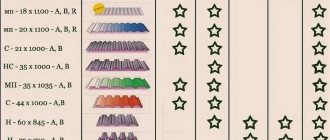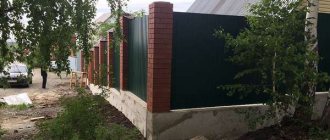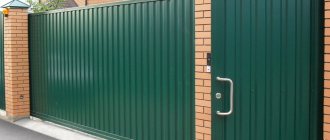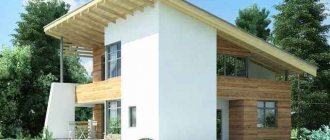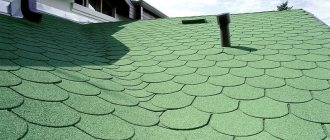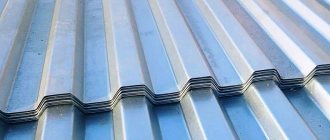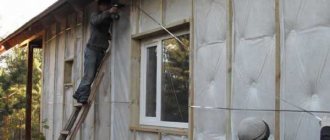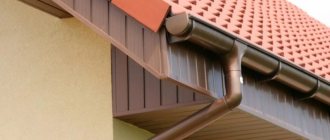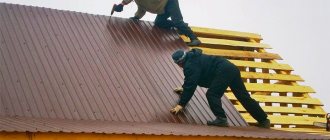Homeowners often choose corrugated sheeting as a roofing material. It has the following advantages:
- Inexpensive.
- Long lasting.
- Practical (easy to install, easy to care for).
- Features a wide range of shades.
- It is not susceptible to rust or exposure to ultraviolet radiation.
- Has a light specific gravity.
- Made to individual sizes.
Let's look at how to understand the markings of corrugated sheets and what types of roofing sheets are available in the Metal Profile Company's assortment. We will also share tips on how to choose the right corrugated sheeting for the roof of a private home and industrial premises.
What is the difference between roofing sheets and corrugated sheets?
Profiled sheets are tougher, more durable than corrugated sheets, and their range is much larger.
Corrugated sheeting is characterized by a high degree of noise absorption, but when finishing the roof with corrugated sheets, it is necessary to additionally use soundproofing materials. Also, due to the fact that corrugated sheeting is a rigid structure with complex terrain, this allows it to be used during installation at any height, and it can withstand heavy loads.
In fact, corrugated sheets and corrugated sheets are the same material , only corrugated sheets are most often called roofing material, and corrugated sheets are a universal coating.
Required roof slope
The angle of the roof does not matter for laying corrugated sheets
Manufacturers guarantee that corrugated sheeting works well in roof slopes of more than 12°, while the maximum slope can be 70° or more. According to SNiP standards, the recommended angle is standardized at 20° as the most rational option. To cover roofs with an average angle of inclination (15 - 35°), grade C21 is often used. The height of the wave is 21 mm, and the thickness of the corrugated sheet for the roof is 0.8 mm; capillary gutters are provided for drainage of liquid.
Load-bearing varieties of grades H60 - H75 are installed on flat roofs; the sheets have a high degree of resistance to static forces. The minimum slope retains water and it drains more slowly. Attention is paid to small joints and crevices where moisture can seep in. Places where sheets overlap each other are sealed with roofing hermetic compounds.
Types of roofs:
- Flat coatings include those that are inclined at an angle of no more than 5°;
- pitched - more than 20°.
The thickness of the corrugated sheet depending on the angle of the roof
On steep slopes, sophisticated products of grades C8 - C12 are used. The pressure from snow on the sheets is minimal, water and moisture from thawing are easily removed beyond the coverage. The material has a reduced load-bearing characteristic; it is more difficult to work with thin profiled sheets. Roofs with a slight slope include those with a slope of less than 25°, medium slope - up to 40°, and steep roofs are those with an angle greater than 40°.
Flat roofs are built with reinforced rafters that can support a lot of weight, while pitched roofs involve saving wood on the roof frame. For decking with a slight slope, choose a profiled sheet with a high pitch, which is more expensive than material with a low ridge height, which is used for pitched roofs.
The minimum slope of a roof made of corrugated sheets is determined taking into account wind pressure, therefore, when choosing an angle, climatic conditions and the estimated wind strength in the construction region are taken into account. Take into account the mass of the insulation, the weight of the corrugated board, sheathing, and rafters. The transverse overlap increases as the angle of inclination decreases; at an angle of up to 15°, the overlap of the top sheet onto the bottom is 20 - 25 cm.
Advantages and disadvantages
Advantages of the material:
- The corrugated sheet has significant resistance to corrosion, ultraviolet radiation and precipitation.
- Due to the presence of sliding properties , snow or dirt does not remain on the roof, but immediately flows off it.
- The long shelf life of the material is about 50 years.
- You can easily and without problems install the coating without having much experience in construction.
- Versatility in use.
- Nice appearance .
- Environmental friendliness and safety of corrugated sheets. At high temperatures, toxic compounds are not released.
- The low weight simplifies the process of transporting the corrugated sheet to the construction site.
- The affordable price for purchasing profiled sheets allows you to purchase it at average costs.
- Provides reliability and protection against leakage .
Disadvantages of a professional sheet:
- becomes very hot in sunny weather .
- Poor sound insulation - pronounced sound from precipitation hitting the roof.
- If the installation of construction work is carried out unprofessionally, then the tightness of the roof may be compromised .
As you can see, the disadvantages are in the minority, and this allows us to talk about the versatility, high practicality and functionality of the material.
Corrugated sheet covering
First, let's decide on the appearance of the material. The corrugated sheet can be simply galvanized without a polymer coating or with a polymer coating.
In both cases, the steel sheet is coated with a zinc compound that protects the material from corrosion. This is realized by the hot method, when the sheets are immersed in molten zinc, or by the electrolytic method, when zinc powder settles on the surface of the steel during the electrolysis process.
Needless to say, regular galvanizing without a polymer coating will be the cheapest option to use. Such a sheet is not suitable for the roof of a residential building, but using it on the roof of a garage, utility room or other auxiliary building is quite justified. The service life of such corrugated sheets is 10-12 years and manufacturers rarely give a guarantee for their rental for more than 2 years.
Corrugated sheeting with a polymer coating will last much longer on the roof. To do this, additional production steps will include priming on both sides of the profiled galvanized sheet and subsequent spraying of a polymer coating on one or both sides. The polymer coating, in turn, can be glossy (the most budget-friendly solution is polyester) or matte (more expensive coatings based on polyvinyl chloride).
Types of corrugated sheets for roofing and choosing the best
The load-bearing type is intended for creating partitions and finishing walls. It can be purchased at a low price, and you can also place an individual order when you need sheets of a certain size.
With its help, you can not only construct some elements of the building, but also easily repair the roof, finish the facade, its walls, ceiling, and even build durable fences.
When calculated per square meter, this material has low weight and good strength.
The wall profile sheet has a rectangular or trapezoidal profile with a polymer coating or can be galvanized. If you make walls from it, they will be much lighter in weight than buildings made of reinforced concrete. Wall corrugated sheets are convenient and easy to cut if you need to do façade cladding or cladding work, install load-bearing elements, and also make decorative metal structures.
IMPORTANT!
Which corrugated sheet is better for the roof of a house? Roofing profiled sheets (H series) are used for the construction of roofs and any fences that can withstand bad weather. It can withstand heavy loads.
Types of profiled sheets
What to look for when choosing?
- Metal thickness of corrugated roofing . This is one of the most important criteria. The roofing sheet must have a high load-bearing capacity and withstand the weight of a person who goes onto the roof to carry out installation or repair work, the weight of the snow cover and wind loads. The load-bearing capacity is affected by the thickness of the steel and the type of profile (we will talk about it in the next paragraph). The optimal thickness of corrugated sheeting for roofing is: 0.5 mm - for a private house, 0.6–1 mm - for industrial and civil construction.
- Profile . As we noted earlier, the type of profile affects the rigidity of the material and its ability to withstand loads. The higher the waves, the stronger the profiled sheet. Additional stiffening ribs also increase the material's resistance to mechanical stress.
- Sheet length . For slopes less than 4 m, we recommend ordering corrugated sheeting that matches their length. In this case:
- the roof becomes more aesthetic (since there are no horizontal joints);
- installation is significantly simplified and accelerated;
- costs for excess roofing material are reduced.
- Coverage . For the roof, we recommend choosing a profiled sheet with a polymer coating. It looks aesthetically pleasing and is reliably protected from the effects of negative factors. Choose the color and texture of the decorative protective layer to suit your taste. Metal Profile Company's product range includes coatings in three segments:
- Premium:
- Premier:
- Standard:
- Availability of a guarantee, compliance with the requirements of quality certificates. The material must be of high quality. An inexpensive profiled sheet from an unknown manufacturer may last significantly less than you planned; the roof will have to be repaired or replaced, and this will entail a significant investment of money and time. Metal Profile Company specialists carefully monitor all stages of corrugated sheet manufacturing. The profiled sheet undergoes appropriate tests; its quality is confirmed by certificates. The manufacturer provides a guarantee of up to 40 years* for steel products with polymer coatings (the warranty period depends on the type of coating).
VikingMP® E (thickness - 45 microns). Durable polyurethane-polyester coating with a matte surface that visually changes shade depending on the lighting. The unusual texture will attract attention to your roof. The warranty period is up to 30 years*.
PURMAN® (thickness - 50 microns). Glossy coating based on polyurethane. It is characterized by mechanical strength and excellent resistance to any external influences; it can be used in harsh climates. The warranty period is up to 40 years*.
AGNETA® (double-sided, outer layer - 30 microns, internal - 25 microns). Shiny glossy finish, visually almost indistinguishable from copper. Resistant to any weather and mechanical influences. A roof made of corrugated sheets with such a coating will become a bright accent and will make your house stand out from the background of neighboring buildings. The warranty period is up to 25 years*.
CLOUDY® (thickness - 25 microns). An original matte finish with a heterogeneous pattern resembling natural ceramics. Durable and fade resistant. Thanks to its universal shade, it is suitable for buildings in any style. The warranty period is up to 30 years*.
PURETAN® (thickness - 35 microns). Practical textured glossy finish based on polyurethane. It is difficult to damage, it is resistant to scratches, corrosion, and any weather influences. Belongs to the middle price category. The warranty period is up to 30 years*.
Norman MP® (thickness - 25 microns). Available in a glossy polyester finish. It is distinguished by verified performance characteristics (color fastness, resistance to corrosion and mechanical stress). The warranty period is up to 20 years*.
VikingMP® (thickness - 30 microns). A textured matte finish that looks more expensive than it costs. Plastic, resistant to fading and climatic influences. Warranty period - up to 10 years*.
Polyester (thickness - 25 microns). Inexpensive coating with a glossy surface. It has good decorative and protective qualities and a wide range of colors. Warranty period - up to 10 years*.
Technical characteristics of the coating
Before purchasing materials from corrugated sheets, it is recommended to find out some details about the features of its use in construction for several reasons:
- To choose for yourself the best and most suitable type from all the profiled sheets for cladding a facade or for building a fence, and also to know what the requirements are regarding the size of the sheets used , since the possibilities of using the material depend on them.
- If you know the dimensions of the material, then you can calculate the required quantity to purchase and thereby save your time when choosing.
- You will be able to purchase the profiled sheet that meets all the requirements established by GOST 24045-94 .
Features of manufacturing profiled sheets
Corrugated sheets are formed using special equipment from high quality sheet steel. The cold pressing method allows you to give the sheet a special configuration by extruding protrusions of a wavy, trapezoidal or rectangular shape. Thanks to the resulting relief, the sheet material acquires the necessary rigidity and the ability to withstand increased loads.
Profiled sheets are a popular material in civil and industrial construction. It is used for cladding structures, installing permanent formwork, erecting fences and arranging roofs. Each type of work has its own requirements for the characteristics of sheet material.
An example of laying flooring without joints along the length
The main parameters of corrugated sheets, including those brands that are suitable for roofing work, include the length and width of the sheet, its total and usable area, metal thickness, relief characteristics (wave pitch and height, its configuration).
Corrugated sheet for roofing: dimensions and weight
Profiled sheets have a wide range of lengths and thicknesses. In accordance with the rules of GOST 24045-94, the length for all types of profiled sheets can be from 2.4 to 12.6 meters, and the width ranges from 600-1850 mm and is determined based on the manufacturer’s brand . The strength of corrugated sheets primarily depends on their thickness.
The standard thickness of corrugated sheets for roofing is 0.5 and 0.55 mm.
You can see the weight of the corrugated sheet in the table:
| Art. corrugated sheets | Thickness, mm | Length weight, kg/m | Weight, kg/m2 |
| Supporting corrugated sheeting | |||
| H57-750 | 0,7 | 6,5 | 8,67 |
| H57-750 | 0,8 | 7,4 | 9,87 |
| H60-845 | 0,7 | 7,4 | 8,76 |
| H60-845 | 0,8 | 8,4 | 9,94 |
| H60-845 | 0,9 | 9,3 | 11,01 |
| H75-750 | 0,7 | 7,4 | 9,87 |
| H75-750 | 0,8 | 8,4 | 11,2 |
| H75-750 | 0,9 | 9,3 | 12,4 |
| H114-600 | 0,8 | 8,4 | 14,0 |
| H114-600 | 0,9 | 9,3 | 15,5 |
| H114-600 | 1 | 10,3 | 17,17 |
| Profiled sheet type NS (universal roofing) | |||
| NS35-1000 | 0,5 | 5,4 | 5,4 |
| NS35-1000 | 0,55 | 5,9 | 5,9 |
| NS35-1000 | 0,7 | 7,4 | 7,4 |
| NS44-1000 | 0,5 | 5,4 | 5,4 |
| NS44-1000 | 0,55 | 5,9 | 5,9 |
| NS44-1000 | 0,7 | 7,4 | 7,4 |
It is also quite common to make sheets with a thickness of about 0.75, 0.8, 1 m. The dimensions of the corrugated sheets for the roof depend on the area where they are planned to be installed, purpose, loads and climate.
The width of the profiled sheet depends on its brand, for example, for the NS35 brand the width of the profiled sheet is 1060 mm and the height is 35 mm . Accordingly, the height will be from 0.5 to 0.8 mm. If you chose the H75 sheet grade, then the sheet width will be 800 mm, the profile height will be 75 mm and the metal thickness will be 0.7-0.8 mm.
Sheet sizes
Standard sizes
The dimensions of corrugated sheeting are another advantage of this material; they allow you to select sheets that are optimally suitable for laying the roof covering. Different brands of corrugated sheets are distinguished by 4 parameters - the thickness of the steel base, the width and length of the sheet, as well as the shape and height of the profile wave. The scope of use and cost of the material depend on these criteria. For the construction of fences, sheets with a small thickness and length are used, which are convenient to place between the supports. And for the construction of the roof, corrugated sheeting with a wave height of at least 50-60 mm is used. Roofing material produced on the basis of profiled steel sheets has the following standard dimensions:
- The length of the corrugated sheet depends on the area of application of this material. Manufacturers use rolling mills that can produce sheets up to 14 m long. Corrugated sheets used for roofing residential buildings are usually cut into sheets 6 m long, since increasing the length beyond this makes transportation unreasonably expensive.
- The width of the profiled sheet is limited by production conditions. The rolled thin-sheet galvanized steel entering the press has a standard size of 1250 mm, and what the width of the material will be after leaving the conveyor depends on the shape and height of the wave. The width of load-bearing corrugated sheeting grade C75 is only 800 mm, and the same parameter for wall grade C8 is 1200 mm, despite the fact that they are made from the same source material. That is, the width of the material depends on the shape and height of the profile.
- The thickness of the corrugated sheet used for roofing is 0.45-1.2 mm. This indicator affects the strength, load-bearing capacity and durability of the material. In addition, the thicker the corrugated sheet, the more expensive it is.
Main brands of corrugated sheets
Standard stamp sizes
Note! Roofing corrugated sheeting differs from wall sheeting in profile shape and height. The waves of this material are on average higher, which allows for better drainage of melt and rainwater accumulating on the slopes. In addition, it is often equipped with additional stiffening ribs that increase the strength and load-bearing capacity of the material.
Coating features
Profiled sheets are specially marked in order to indicate their differences between each other, including their purpose and their types. They are designated by Latin letters ( C – wall, N – load-bearing ).
NOTE!
The durability and strength of the entire structure is ensured by the fact that the profiled sheets have 8 protective layers.
Due to the fact that high-quality corrugated sheets are coated with a varnish coating (polyester, polyvinyl chloride) during their production, they look aesthetically pleasing. Their shelf life also increases.
The material has many positive properties:
- fluorescent;
- heat resistant;
- anti-corrosion;
The material can easily withstand any external influences and is environmentally friendly.
Marking
What do the letters and numbers mean in the marking of corrugated roofing sheets?
The letter means the functional purpose of the corrugated sheet: “N” - load-bearing, “S” - wall (with the exception of the “MP” marking: these are the initials of the manufacturer, Metal Profile Company). The “K” (roofing) marking does not exist. A logical question arises: is corrugated wall sheeting suitable for the roof? - Yes, it will do. To install the roof, you can use wall and load-bearing materials (we will discuss the selection rules below).
The number is the height of the profile in millimeters: S-21 - 21 mm, MP-35 - 35 mm, etc. The higher the profile, the stiffer the profiled sheet. Also, the profile height affects the useful width of the corrugated sheet. All profiled sheets are made from standard blanks with a width of 1250 mm. When a steel sheet is given the required shape, part of the material “goes” into waves and additional stiffening ribs. Accordingly, the higher the waves and the more stiffening ribs, the smaller the width of the finished material.
Where can corrugated sheets be used?
- During the construction of fences, both permanent and temporary, for the purpose of carrying out repair work.
- To create parking lots and parking lots for cars or sheds at places of sale of products.
- When permanent formwork is made during the construction process.
- To make sandwich panels using special European technology for arranging wall coverings.
Profiled sheets are used as insulation for facades of various types of premises:
- industrial;
- residential;
- commercial;
- for making roofs on roofs of various buildings.
If you need to make floors in buildings, ceiling and wall partitions are created from corrugated sheets.
Photo of a roof made of corrugated sheets
Bearing profiled sheet.
The load-bearing corrugated sheet is characterized by the highest height of the corrugated profile, which starts from 57 mm; the metal thickness can reach up to 1.20 mm . This material is especially actively used, mainly in the construction of industrial buildings and structures. It also finds application in the construction of individual residential buildings, where it is used as permanent formwork for foundations and interfloor reinforced concrete floors. The thickness of the sheet used depends on the size of the floors, free spans, fastening of the edges of the slab and is 0.70 mm - 1.00 mm. As a rule, the corrugated sheet in this case is cut into sheets in sizes according to the customer’s project. The length of the sheet is up to 12 meters.
Saving on sheet thickness is not only unacceptable here, but also deadly, as it can lead to the collapse of the structure!
Floor slab using formwork made of load-bearing corrugated sheets
Thus, in this short article we tried to determine the scope of application of profiled galvanized steel sheet, depending on its thickness. Based on this, each person can calculate the expected costs in advance and choose the most optimal option.
Most popular markings
Today, there are a large number of materials made from corrugated sheets and, as a rule, only some of them are most actively used, which are much better and easier to use. The most popular markings of profiled sheets include:
- C8 . This marking of profiled sheets is most often used for decorative wall coverings . The performance characteristics of this brand have much in common with C10 sheets, which are ideal for building high fences whose dimensions reach more than 250 cm.
- H57 . Corrugated sheets are rigid and suitable for erecting various fences and have an attractive appearance.
- H75 . Corrugated sheets of this brand are suitable for absolutely any type of construction work and are stable if fencing in the form of walls is made from them.
- C21 . Materials made from corrugated sheets can be used for roofing, fencing and wall cladding .
- C18 . Profiled sheets are made in the form of ordinary galvanized products and coated with all sorts of polymer materials. They are intended for installation of roofs on pitched roofs and panel fences.
- NS44 . This brand can be used for any construction and installation work.
Brands of corrugated sheets
Typically, corrugated sheets are made of sheet steel with zinc and aluminum-zinc coating. If they use an aluminum-zinc coating, they put AC in the marking, if they use zinc, they don’t put anything. If zinc is applied electrolytically, then EOTS is installed. The sheet can also be coated with a layer of aluminum (letters AL in the marking) or aluminum-silicon (AK). These coatings provide better protection, but are expensive.
Profiled steel sheet with a protective coating - this is corrugated sheeting
In addition to various “primary” coatings, rolled steel sheets are used in various thicknesses. In combination with different profiles, it has different load-bearing capacities, accordingly, it has different purposes and areas of application. According to their purpose, profiles are divided into types (GOST 24045-2016):
- N - for load-bearing covering decks that support the weight of the roof with insulation and the load of climatic influences;
- NS - for flooring and wall fences;
- C - for wall fences that perform load-bearing and enclosing functions.
Sometimes there is such a decoding of the designations of corrugated sheets, where type H is load-bearing (for load-bearing covering decks that bear the weight of the roof with insulation and the load of climatic influences). He is the heaviest, the toughest. Roofs with high snow and wind loads are made from this corrugated sheeting.
Brands of corrugated sheets and their purpose
NS - load-bearing wall. Another name is universal. Less “hardy”, but can be used on the roof with low loads on it. It is also possible to build load-bearing walls from it (with sufficient thickness and depth of the relief). He is often “allowed” onto fences that do not have crossbars between the posts.
C - wall profiled sheet. Used for cladding frame walls. It is used in the construction of garages from corrugated sheets and utility rooms. The same type, but of sufficient thickness, can be attached to the fence if there are crossbars between the posts. This material is not recommended for roofing. Unless there is almost no snow and wind. And then, the sheathing should be frequent, with small gaps.
Roofing from corrugated sheets: calculation of the number of sheets
To calculate the material for the roof, you will definitely need information about the dimensions of the material used and the roof. To begin with, it is recommended to start by calculating the rafter system.
You also definitely need information about the expected weight of the finished structure, and the cross-sectional values of the beams, taking into account the coating material.
The main components of the rafter system are logs and beams , which are intended for the construction of the roof frame. The calculation of the pitch of laying the beams is done after calculating the load on the roof, which takes into account the weight of the roof, its covering and its own weight.
This is done to provide for all possible loads on the roof. In addition, the calculation of the load includes the weight of the workers who will be installing it and strong gusts of wind.
Attention!
To calculate the covering and rafter system, use our online calculator! After calculating the total load, the number of wooden beams is calculated, which are distributed in a certain direction at angles.
Calculations:
- In order to determine what load will be optimal for a linear meter of parts of the rafter system, you need to use tables with detailed calculations that are found in specialized literature on construction.
- The total footage is calculated.
- The total number of beams is calculated by measuring the length of one of them.
Calculation of the size and number of corrugated sheets for roofing
Let us recall that the useful length of a corrugated sheet is optimally equal to its full length. Therefore, to calculate the required number of sheets, there is no need to calculate the roof area and divide it by the sheet area. This is done much simpler: the width of the slope with a correction factor must be divided by the useful width of the metal profile sheet.
Let's calculate the number of sheets required for roofing for a regular pitched roof.
A pitched roof allows you to most simply demonstrate the algorithm for calculating the number of corrugated sheets required for a roof
For example, let’s take a roof with a roof slope width of 12 meters and calculate the required number of sheets of NS-35 grade corrugated sheets.
- We multiply the width of the slope by a correction factor of 1.1. This is necessary to take into account overhangs, waste and the possibility of damage to the sheets during transportation and installation. We get 12 ∙ 1.1 = 13.2 m.
- To determine the number of sheets, divide the resulting value by the useful width of the sheet. Since the useful width of the NS-35 sheet is 1 meter, we divide 13.2 by 1 and get 13.2. We round the result up and understand that to arrange the roof we need 14 sheets.
- We count the amount of corrugated sheeting in square meters. This will be useful for determining the cost of roofing material. We multiply the number of sheets by the length of the sheet (for example, 6 meters) and by the full width of the sheet (for sheet NS-35 it is 1.25 meters). We get: 14 ∙ 6 ∙ 1.25 = 105 m2.
For a gable roof, a similar calculation must be carried out for each slope. If the slopes are the same, then the resulting value for one of them just needs to be multiplied by 2.
If two sheets or more are laid along the length, the calculation is made slightly differently:
- Calculate the roof area. The slope has the shape of a rectangle, so its area will be equal to the product of the sides: S = 12 ∙ 6 = 72 m2 (the transverse size of the slope together with the eaves overhang is taken to be 6 m).
- We multiply the roof area by a correction factor of 1.1. We get S = 72 ∙ 1.1 = 79.2 m2.
- We divide the resulting value by the usable area of the sheet. Let's assume that sheets with a length of 3.5 m are used. Then the useful length will be equal to 3.25 m (we set aside 25 cm for the longitudinal overlap). We calculate the usable area as the product of this value and the usable width (1 m): Sfloor = 3.25 ∙ 1 = 3.25 m2.
- We calculate the number of sheets, for which we divide the total roof area by the usable sheet area: N = S / Sfloor = 79.2 / 3.25 = 24.37. This means we will need 25 sheets of corrugated sheets measuring 3.25 x 1.25 m.
You can also make a preliminary calculation of the roofing material using one of the online calculators, of which there are quite a few on the Internet.
Video: calculation of roofing materials using an online calculator
The relationship between the type of corrugated sheet, the angle of inclination of the roof and the maximum pitch of the sheathing
The technical characteristics of different types of profile determine its use for roofs with certain angles of inclination and pitch of the sheathing.
Table: influence of the profile type on the roof slope angle and sheathing pitch
| Marking | Roof angle | Maximum sheathing pitch |
| S-20 | up to 15o | Solid |
| more than 15o | 50 cm | |
| S-21 | up to 15o | 30 cm |
| more than 15o | 65 cm | |
| S-44 | up to 15o | 50 cm |
| more than 15o | 100 cm | |
| N-60 | more than 8o | 3m |
| N-75 | more than 8o | 4 m |
| NS-35 | up to 15o | 50 cm |
Profiled sheets marked “C” are cheaper than other brands. Therefore, they are often used for roofing. However, it is still better that in this case the roof slope is 45o or more. With such a slope, the snow will melt quickly and water will not penetrate inside through the joints. In addition, when using sheet “C” for the roof, the sheathing must be made frequent or continuous.
Roofing pie
A roofing pie is a structure consisting of several layers, which is made to create a roof . It consists of lathing and counter lathing, vapor barrier, waterproofing and roofing. The only thing that is not included is the rafter system.
Installation of the roofing pie is done in this way:
- Take the counter-lattice and install it on the surface of the rafter system. You can attach slab insulation between the beams if the roof is made of corrugated sheets, gable, hip or multi-gable.
- Waterproofing materials are placed on the insulation.
- For the profile sheet, you need to install the lathing, taking into account the gaps for ventilation.
- Roofing profiled sheets are laid out.
Roofing pie
The use of profiled sheets is quite diverse and ensures a long service life. Thanks to this material, it is possible to make both individual structures in the form of fences and install the roofing pie. Unlike corrugated sheeting, it has many advantages that make it indispensable in the construction process.
What is a profiled sheet
Corrugated sheets are metal sheets of various thicknesses and sizes with a protective film
Profiled metal sheet products are produced by cold rolling in factories. Rigidity is provided by the steel base, and the embossing adds rigidity to the material without adding weight. The colorful coating adds attractiveness, and the protective film on the surface increases resistance to negative factors.
Performance properties depend on the following indicators:
- thickness of the galvanized layer and base;
- type of polymer used;
- polymer film thickness;
- distances between waves.
Various types of corrugated roofing are produced in two stages. In the first stage, galvanized metal plates are rolled between rollers, resulting in a corrugated surface that produces repeating waves. They use steel with a paint and varnish polymer coating, the color of which is regulated according to the RAL catalog; in other cases, material without a film is used.
Types of polymer layers:
- AK - acrylate;
- PE - polyester;
- PVC - plastiesol;
- PVDF - polyvinylidene fluoride;
- PUR - polyurethane.
For the roof, you can choose sheets up to 12 m long, which avoids joining seams
The second operation consists of cutting the material, resulting in the required dimensions of the corrugated sheet for the roof. The width and length of products are determined by the state standard, or the dimensions are made according to the client’s order.
Advantages and disadvantages of corrugated sheets:
- ease of design, installation in mounting position;
- hides surface unevenness;
- the length of the sheet (up to 12 meters) allows you to cover long roofs without joining;
- Reliably resists destruction from corrosion, long service life;
- large selection of colors;
- low weight allows you to reduce the cross-section of the rafters and the thickness of the walls.
The disadvantages of using corrugated sheets include high sound when raindrops hit and birds appear. The effect is eliminated by installing a protective layer against noise in the form of mineral wool or other similar material. When the sheet is cut, damage to the protective film is observed; such a place is weakened and subject to corrosion.
What is corrugated sheeting
Profiled sheet or corrugated sheet, or as it is also called, corrugated sheet, is a popular facing building material made from galvanized steel sheet with a thickness of 0.4 to 0.9 millimeters using the cold rolling method, during which the product acquires various corrugated shapes (wavy, square , trapezoidal and others) in order to increase rigidity.
The corrugated sheet can be galvanized or with an additional polymer coating of different colors. The polymer is applied to one or two sides of the sheet. The most common option is one-sided application of the polymer. In this case, a protective layer of paint and varnish is applied to the back side of the corrugated sheet.
Corrugated sheeting is used on the roofs of various types of buildings, construction of external fencing, fences, wall cladding of private and commercial buildings, hangars, warehouses, garages.
Corrugated roofing - practical advice on choosing
- appearance of the profiled sheet . This is the easiest way to determine which roofing sheeting is better. Of course, one that does not have defects, chips, peeling or paint sagging, “stretch marks”, etc.;
- clear geometry of the dimensions of the roofing corrugated sheet . The manufacturer is obliged to provide the opportunity to measure each profiled sheet in thickness, length and width. Deviations greater than the minimum acceptable (according to GOST 24045-2010) are a sign of a violation of the manufacturing technology. Even knowing how to properly attach corrugated sheets to the roof, it will not be possible to efficiently install obviously defective sheets (substandard);
- geometry of the overlapping wave . The first wave of the top sheet should very accurately cover the last wave of the bottom sheet. In this case, the likelihood of water getting under the sheet will be minimized;
- edge quality . Chopping (cutting) corrugated sheets in the factory is carried out with a special device - a guillotine. This cut is very accurate and smooth (without nicks or paint sagging). This is an indicator that the sheet will not begin to rust from the edge;
- strength of roofing corrugated sheets . When demonstrating the color scheme, the seller will most likely show you a selection of round swatches. This shape was not chosen by chance; a round sample is more difficult to bend than a square one. Therefore, the sheet appears durable.
In practice, you can check the strength of a corrugated sheet in a simple way by applying a little force: with slight bending, the corrugated sheet will easily return to its previous shape, but with strong pressure, the bend will remain.
- Availability of specifications and layout of corrugated sheets . This does not apply to the choice of corrugated sheet directly, but it is mandatory when purchasing material for the entire roof. After all, you need to not only know how to choose corrugated sheeting for the roof, but in what order the purchased sheets should be placed, especially in the case of a roof with a complex configuration;
- packaging of corrugated sheets . Its presence is important only at the stage of storage and transportation. It must be removed before installation. After prolonged exposure to ultraviolet radiation on the protective film on the corrugated sheet, it cannot be removed and significantly spoils the appearance of the roof;
- guarantees and certificates for professional sheets . Allows you to judge the reliability and responsibility of the supplier.
Scope of application and purpose of roofing corrugated sheeting
The choice of corrugated roofing begins with determining the location of its installation. It is this that serves as the starting point and determines the sheet selection criteria and, ultimately, the cost of the project.
Due to its high performance qualities and reasonable price, corrugated sheeting is used as a roofing material in private construction for:
- country houses, country houses, cottages;
- garage and outbuildings;
- gazebos, verandas, canopies;
- temporary buildings.
Naturally, the requirements when choosing a roof for each of the objects will be different. For example, when choosing corrugated sheeting for a residential building, you need to take into account the coverage area, roof configuration, number of slopes, average annual precipitation, installation complexity, difficulty of replacing sheets and other factors.
At the same time, the canopy roof over the porch or front door can be made of cheaper or more practical material. The small area ensures high maintainability of the roof, and the level of precipitation does not have a significant effect on the roof.
Profile Features
Corrugated roofing sheets must withstand atmospheric and operational loads and actively remove moisture falling on the roof. These properties are largely determined by the height and configuration of the profile. The higher the wave, the greater the load the material can withstand
.
When assessing the configuration, pay attention to the presence of additional longitudinal stiffeners - such material is more resistant to high loads
. Stiffening ribs on sheets with a trapezoidal profile are located on the edges of the trapezoids or between the bases. Material with increased longitudinal rigidity can be mounted on a flat roof; when installing pitched structures, it is allowed to increase the sheathing pitch.
Profile with increased longitudinal rigidity
For the roofing, a load-bearing profiled sheet (H) or a universal sheet (NS) is used. For light canopies, the use of wall canopies (C) is allowed.
A specialized roofing sheet differs from a conventional load-bearing sheet by the presence of a capillary groove, which is located on the edge of the sheet, which is overlapped on top by an adjacent element. The capillary groove removes moisture that has penetrated under the flooring.
Characteristics of some popular profile brands
If the roofing sheet is made of steel thinner than 0.5 mm, the edge of the capillary groove is easily deformed during loading or unloading, during lifting of the material onto the roof and installation. In this case, the groove cannot perform its function, and moisture gets inside the roofing pie.
To purchase the required amount of roofing material, it is necessary to perform the appropriate calculations, which take into account the surface area of the slopes, the roof structure, as well as the type of profile and the corresponding standard dimensions of the corrugated sheet.
Be sure to read: How to choose corrugated roofing: selection criteria
Calculation of sheet length
If corrugated roofing is chosen as a covering, the size of the sheet and the price of the material must be indicated in the design and estimate documentation along with its brand.
Ideally, the length of the sheet should correspond to the dimensions of the slope, so that each strip does not have to be assembled from several elements. This coating is more resistant to stress and leakage. But it should be taken into account that it is difficult to lift a profiled sheet more than 6 meters long onto the roof and secure it without deforming it.
If you decide to purchase standard format material for laying the roof, you need to calculate how many sheets it will take to install one strip. Calculations are carried out using the formula N=(A+B)/D, while
- A – slope length;
- B – length of the edge of the sheet, which should protrude beyond the edge of the cornice (5-10 cm);
- D – length of the profiled sheet;
- N – number of sheets.
Next, perform the calculation using the formula N1=N+N×C/D, while
- C – overlap length (from 15 to 20 cm, the exact value is indicated by the manufacturer).
- Then the resulting values (N and N1) are summed and rounded to the nearest whole number.
Calculation of sheet width
To calculate how many sheets of corrugated sheets will be laid along the width of the slope, you need to divide the width of the slope (horizontal length) by the useful width of the roofing sheet. To the result obtained, add 50 mm to the eaves projections. For each slope of a complex roof, the calculation should be performed separately.
Installation of profile on the roof
It is rational to use large cuttings for installing coverings on other areas of the roof. In this case, on each of the slopes the sheets are mounted in only one direction, and the trim may turn out to be symmetrical and cannot be installed due to the difference in the size of the lock flange. This should be taken into account when designing and calculating the roof covering.
Rules for caring for corrugated sheets
After installation, no special maintenance of the structure is required, however, there are some rules that should be followed to increase its service life. The polymer coating will protect the structure from mechanical damage, direct sunlight, corrosion and chemical exposure. If the surface is heavily soiled, it is enough to wash it with a soap solution that does not contain solvents (they can damage the coating). If scratches occur, it is better to paint them over with paint of the appropriate shade. In winter, it is important that the layer of ice does not damage the surface of the roof if it is made of corrugated sheets.
Buying profiled sheets is a serious matter and requires attention to detail from the buyer. When choosing, take into account the tips presented in the article, and also consult with specialists. Depending on your wishes, you can choose various decorative coating options: photo printing, painting, applying a polymer layer, etc. Our team will help with the purchase; our managers will advise on the material, its dimensions, taking into account the installation location and other data from the customer.
